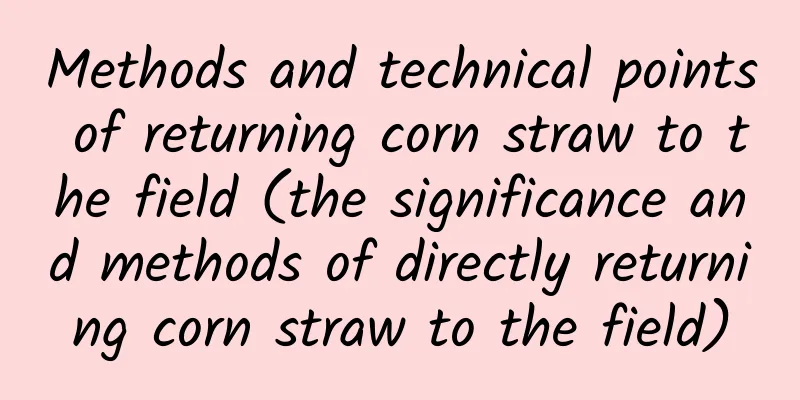Methods and technical points of returning corn straw to the field (the significance and methods of directly returning corn straw to the field)

|
Returning corn stalks to the fields is an important way to increase the application of organic fertilizer. In recent years, with the rise of migrant workers, the outflow of labor, and the reduction of livestock breeding, the amount of composted organic fertilizer has decreased year by year or has not been composted. Only inorganic nutrients can be applied to the land, and the amount of organic fertilizer applied is close to zero, so farming cannot nourish the land. This has led to predatory farming, which has greatly reduced the organic matter content in the soil. In the long run, this will cause the soil fertility to decline, increase the input of chemical fertilizers, and increase production costs. The promotion and application of technology to return corn or wheat straw to the fields can truly solve this problem and is also one of the main ways to increase agricultural production yields. Effects and existing problems of returning straw to fieldsThe main function of returning corn stalks to the field is to increase the content of soil organic matter. According to measurements, applying 1,500 kg of fresh corn stalks is equivalent to 4,000 kg of high-quality soil fertilizer, with nitrogen content equivalent to 6.9 kg of urea, phosphorus content equivalent to 10 kg of superphosphate, and potassium content equivalent to 6.5 kg of potassium sulfate, which can effectively improve soil fertility. The application of straw allows beneficial microorganisms to develop fully, changing the physical and chemical properties of the soil, thereby improving the soil, making it suitable for the growth of crop roots and promoting healthy growth of crops. Returning straw to the fields is a farming method that combines planting and land conservation, achieving a virtuous ecological cycle. Everything has two sides, and there are also disadvantages such as : (1) The corn stalks are not completely crushed, the lengths are different, and they are not easy to decompose, resulting in seedling death; (2) The soil is uneven, with large pores and serious air leakage, which makes the plants easily frozen and cause frost damage; (3) Since it has not been fermented, the base number of soil pests and diseases will increase, which may cause a large outbreak of some pests and diseases. Main technical measures for returning straw to fieldsFrom the current use of corn stalks, the benefits of returning corn stalks to the fields are still greater than the disadvantages. However, it is mainly the proper use of technical measures, which must be done according to the operation requirements, to truly eliminate the disadvantages and achieve the purpose of returning corn stalks to the fields and fertilizing the fields. 1. The time for returning farmland to the fields should be grasped accuratelyThe time of returning corn stalks to the field is the key to whether they can be completely decomposed. If it is too early, it will affect corn yields, and if it is too late, the stalks will not have enough time to decompose underground, affecting wheat sowing. The specific time is after the corn cobs are harvested, when the corn stalks and leaves are green and still have moisture, they should be harvested and crushed in time. At this time, the corn stalks have high moisture and sugar content and are easy to crush. The crushing degree is preferably less than 5cm, and it is best to grind it into powder. Spread it evenly on the ground and plow it. 2. Add nitrogen fertilizer to catalyze decompositionWhen plowing the land, first sprinkle nitrogen fertilizer on the crushed corn stalks to catalyze composting and also adjust the carbon-nitrogen ratio. This will facilitate the activity of soil microorganisms and promote the rapid decomposition of organic matter. Apply 45 kg of ammonium bicarbonate or about 10 kg of urea per mu. Other base fertilizers can also be applied together. 3. Deep plowing and fine tillageAfter the crushed corn stalks are returned to the field, the land should be plowed in time. It can also be crushed, fertilized and plowed at the same time to prevent the loss of moisture in the crushed straw. The plowing depth should be 20 to 25 cm, and the straw should be intentionally turned into the plow bottom layer to eliminate the problem of large pores in the topsoil caused by returning it to the field. 4. Return sufficient moisture to the fieldsThere must be enough water in the soil when returning the straw to the field. If it is insufficient, you can water the soil after returning the straw to accelerate the decomposition of the straw and increase the base moisture for sowing wheat. 5. Corn stalk usageThe average yield of fresh corn stalks per mu is 1500-2500 kg. Under normal circumstances, the amount used per mu is 750-1000 kg. Generally speaking, fresh straw can be used for 2 mu of land. Do not return all of it to the field at once to avoid adverse effects. The remaining can be used as compost, and after sufficient fermentation, it can be used as winter fertilizer and topdressing to protect the roots from freezing. 【 Summarize 】 Corn stalks returning to the field is a controversial technical measure. I think the advantages outweigh the disadvantages. Only through continuous production practice can we further understand it and constantly summarize experience and lessons. By verifying perfect measures, the technology of returning stalks to the field can benefit the people. |
<<: What fertilizer do you need to grow chives at home? (What fertilizer do you use to grow chives?)
>>: What does it mean when succulents wear skirts?
Recommend
Diseases and Pests of Helichrysum and Their Control
Sclerotium rolfsii It often occurs in the hot and...
What is the best foliar fertilizer for orchids? (Precautions for spraying foliar fertilizer for orchids)
The orchid has flowing leaves and graceful postur...
Are orchids suitable for the balcony? (What tips should be taken when growing orchids on the balcony at home)
Nowadays, everyone lives in high-rise buildings, ...
Diseases and prevention methods of Cercis chinensis
Diseases of Bauhinia: Angular leaf spot symptom A...
When to take cuttings of northern roses
1. Outdoor cuttings The main factor to consider w...
Is a deep or shallow pot suitable for geraniums?
Is geranium suitable for deep or shallow pots? Ge...
What fertilizer is good for broccoli topdressing?
Broccoli topdressing time After the broccoli surv...
How to grow Polygonatum sibiricum?
Polygonatum sibiricum , as a traditional Chinese ...
What to do if the leaves of Chinese evergreen become soft and black
What to do if the leaves of Chinese evergreen bec...
How to plant lime hydrangea
1. Planting time The planting time must be chosen...
How to grow green apple arrowroot
Green Apple Arrowroot Growing Conditions Green Ap...
Is the lotus poisonous? Can it be placed in the bedroom?
1. Is it poisonous? Lotus is non-toxic and does n...
What to do if the roots of aphid are rotten
1. Replace the soil Reason: The soil in the Aspid...
How did Tia explode?
1. Using leaf cuttings If Tia wants to achieve th...
Why are the leaves of the fragrant wood turning yellow?
Improper watering The seedlings of Fragrant Wood ...









